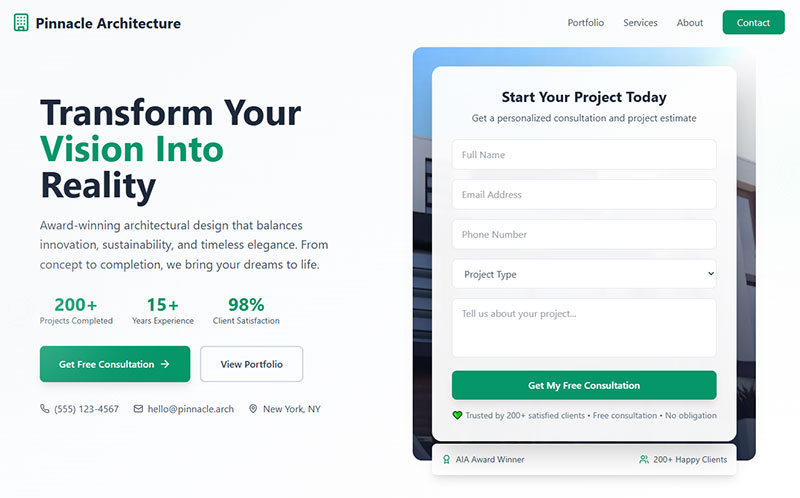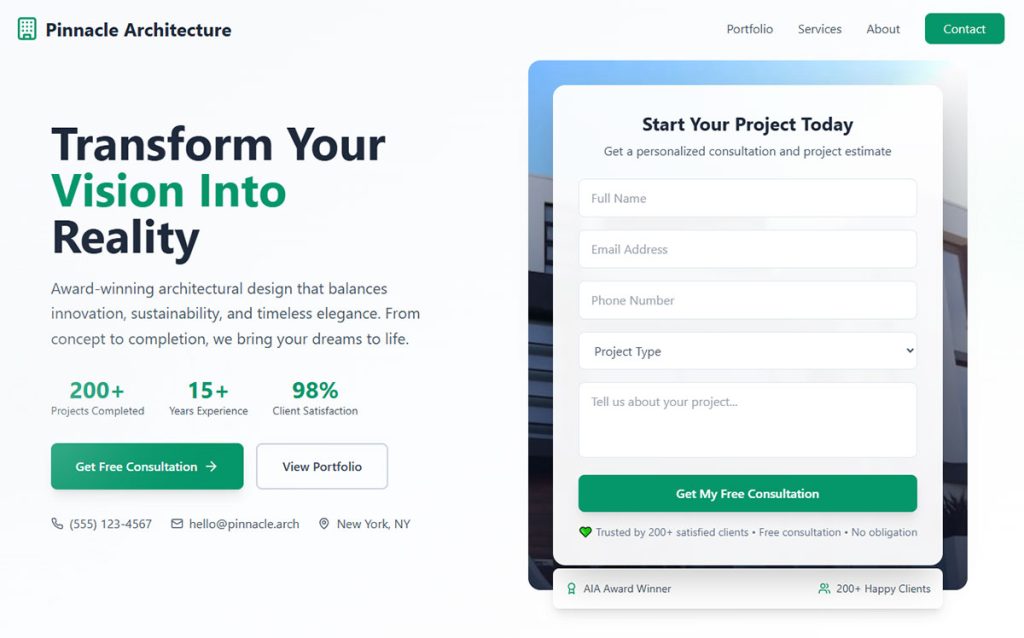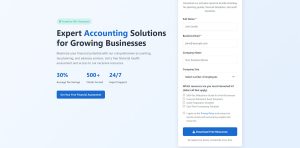Your phone should be ringing. It isn’t. Meanwhile, competitors down the road have jobs booked three weeks out. The difference? Lead generation for fence contractors that actually works. Most fencing…
Table of Contents
Most architects wait for clients to find them, then wonder why their phones stay quiet. Lead generation for architects requires active strategies that attract residential clients, commercial developers, and property owners before they start calling your competitors.
The construction industry has shifted dramatically. Past clients and referrals aren’t enough anymore. Today’s architectural firms need systematic approaches to generate consistent project inquiries and build sustainable client acquisition pipelines.
This guide covers proven methods that actually work for design professionals. You’ll learn how to build a lead-worthy portfolio, implement digital marketing strategies, master traditional networking, and convert prospects into paying clients.
We’ll also show you how to measure results and improve your architectural business development over time. By the end, you’ll have a complete blueprint for attracting the right clients for your architectural services.
Building Your Foundation for Lead Generation
Getting leads as an architect requires more than just posting pretty pictures online. 53% of marketing professionals spend half their budget on lead generation, yet 80% of marketers say their efforts are ineffective. You need systems that actually work.
Creating a Lead-Worthy Portfolio
Your portfolio isn’t just a collection of finished buildings. It’s your primary sales tool for attracting residential clients and commercial developers.
Show your process, not just results. Clients want to see how you solve problems. Include before photos, concept sketches, and construction progress shots. This transparency builds trust with potential homeowners and property investors who need to understand what they’re getting into.
Document your problem-solving approach. Did you navigate tricky zoning requirements? Work around a tight budget for a custom home design? Include these stories because they demonstrate real expertise that property owners value.
Architecture is visual. Local landing pages with images and graphics get 94% more views. Professional photography significantly boosts engagement and gives leads a reason to hire you for similar results.
Track these portfolio metrics:
- Page views per project (aim for 3+ minutes average time)
- Download rates for project sheets
- Contact form submissions from portfolio pages
- Social media shares of individual projects
Building Client Testimonials and Case Studies
Client relationships drive referrals in the construction industry. Past clients become your best marketing team when you treat them right.
92% of consumers trust recommendations from friends and family over any other form of advertising. More importantly for architects, referrals account for 65% of all new business opportunities.
Create detailed case studies for your most successful projects. Focus on the client’s original problem and how your architectural design process solved it. Include specific metrics when possible (budget, timeline, square footage improvements).
Video testimonials work particularly well for residential architecture leads. Homeowners trust other homeowners more than they trust marketing copy. Referred customers have a 37% higher retention rate than those acquired through other methods.
Referral program essentials:
- Offer attractive rewards (25% increase in referral activity with incentives)
- Make referrals easy with simple forms or links
- Follow up systematically (first-time clients refer 3 people, repeat clients refer 7)
Defining Your Ideal Client Profile
Not every project is worth pursuing. Smart architectural firms know exactly who they want to work with.
Architecture firms spent an average of 1.51% of their total revenue on marketing in 2020. With limited marketing budgets, targeting the right clients becomes critical.
Consider project size and scope. Are you targeting luxury custom homes or affordable housing developments? Each requires different marketing approaches and client acquisition strategies.
Geographic boundaries matter too. Most architectural services work best within a specific radius where you can easily conduct site visits and maintain client relationships throughout the design and construction phases.
Client targeting worksheet:
| Criteria | Primary Target | Secondary Target |
|---|---|---|
| Project Size | $_____ range | $_____ range |
| Geographic Area | _____ mile radius | _____ mile radius |
| Property Type | Residential/Commercial | Mixed use |
| Timeline | _____ months | _____ months |
Setting Up Lead Tracking Systems
You can’t improve what you don’t measure. Modern architectural firms need systems to track where leads come from and which ones actually convert.
91% of marketers say lead generation is the top priority for B2B marketers. Yet only 52% of companies leverage landing pages for lead generation, despite their proven effectiveness.
Use a simple CRM that tracks contact information, project details, and follow-up schedules. Many WordPress forms integrate with popular CRM systems to automatically capture prospect information.
Track these key metrics:
- Lead source (website, referral, social media, paid ads)
- Project type and estimated budget
- Timeline and decision-making authority
- Conversion rate by source (industry average: 3.3% across all industries)
Essential benchmarks:
- Companies with 30+ landing pages get 7X more leads than those with 1-5 pages
- Organic search conversion rates: 2-4%
- Websites with 41+ landing pages generate 500+ leads vs. 100 with 1-5 pages
- Response time targets: 5 minutes for phone calls, 2 hours for emails
Implementation Timeline
Month 1: Foundation
- Set up CRM system and tracking
- Create 3-5 detailed case studies
- Build service-specific landing pages
Month 2: Optimization
- A/B test lead capture forms
- Analyze traffic sources and conversion rates
- Launch systematic referral outreach
Month 3: Scale
- Create additional landing pages for different services
- Implement retargeting campaigns
- Refine targeting based on performance data
Success Indicators
You’ll know your lead generation system is working when:
- Referred customers are 4X more likely to refer others, creating a self-sustaining growth cycle
- Customer acquisition costs decrease by 13% with effective referral marketing
- Lead quality improves with more qualified prospects
- 5% increase in customer retention enhances profits by up to 75%
Focus on systems that generate new leads while maximizing the value of existing client relationships.
Digital Marketing Strategies That Actually Work
Digital marketing for architects isn’t about being everywhere online. It’s about being in the right places with the right message. 74% of people are more likely to return to a website if it’s optimized for mobile.
Website Optimization for Architectural Practices
| ✓ | Optimization Task | Priority | Impact |
|---|---|---|---|
| Mobile-responsive design implementation | HIGH | 62.5% of traffic is mobile | |
| Page load speed under 3 seconds | HIGH | 7% conversion loss per second delay | |
| SSL certificate installation | HIGH | Required for SEO & trust | |
| Clear calls-to-action on every page | HIGH | Guides visitor actions | |
| Contact information prominently displayed | HIGH | Reduces bounce rate | |
| Professional portfolio photography | MEDIUM | 94% increase in engagement | |
| Intuitive navigation menu structure | MEDIUM | Improves user experience | |
| Service-specific landing pages (30+ pages) | MEDIUM | 7X more leads than 1-5 pages | |
| Local SEO optimization (Google Business Profile) | MEDIUM | 46% of searches have local intent | |
| Client testimonials and reviews display | MEDIUM | 34% increase in conversions | |
| Analytics tracking setup (Google Analytics) | MEDIUM | Essential for optimization | |
| Blog section with architectural content | LOW | 55% more website visitors | |
| Social media integration and links | LOW | Increases engagement | |
| Newsletter signup form | LOW | Long-term nurturing |
Start with HIGH priority items first. These changes provide the biggest impact on lead generation and user experience. Complete at least 80% of HIGH priority tasks before moving to MEDIUM priority optimizations.
Your website is often the first impression potential clients get of your architectural services. Mobile devices account for 62.5% of global website traffic, making mobile optimization critical.
Fast loading times matter more than fancy animations. A 1-second delay in page load time can reduce conversions by 7%. Potential clients bounce quickly from slow sites, especially when they’re comparing multiple architectural firms.
Include clear calls-to-action on every page. Whether it’s “Schedule a Consultation” or “View Our Portfolio,” make it obvious what visitors should do next.
Essential optimization checklist:
- Mobile-responsive design
- Page load times under 3 seconds
- Clear navigation and contact information
- SSL certificate for security
Portfolio Presentation Strategy
Online portfolios need different treatment than printed versions. Web visitors scan quickly, so lead with your strongest work.
Organize projects by type rather than chronologically. Commercial development prospects don’t want to scroll through residential projects to find relevant work.
Include project details that matter to prospects: budget range, timeline, square footage, and any special challenges you overcame. This information helps visitors self-qualify as potential clients.
Companies with 30+ landing pages generate 7X more leads than those with just 1-5 pages. Professional photography increases engagement by 94%.
Contact Forms That Convert

Generic contact forms waste opportunities. Lead generation forms designed specifically for architectural services capture better information and improve follow-up quality.
Ask about project type, timeline, and budget early in the process. This qualifying information helps you prioritize responses and prepare for initial conversations.
Form design impacts conversion rates significantly. Landing pages with 5 or fewer form fields generate 120% higher conversion rates than lengthy forms.
Content Marketing for Architecture Firms
Content marketing builds authority and attracts prospects who aren’t ready to hire immediately. Content marketing generates 3X more leads per dollar than traditional advertising and costs 62% less.
Write about common architectural challenges in your area. Building code updates, zoning changes, and design trends all make good content topics that demonstrate expertise.
Local content performs particularly well for architectural firms. Write about neighborhood design guidelines, historic preservation requirements, or sustainable design incentives in your market.
Companies that blog attract 55% more website visitors. Case studies (79%) and webinars (66%) are the most preferred B2B content types.
Social Media That Generates Leads
| Platform | Engagement Rate & Lead Quality | Content & Frequency | Best Use for Architects |
|---|---|---|---|
|
Li
Professional Network
1B+ members
|
6.5%
EXCELLENT
B2B focused leads
|
Videos & Articles
Educational content
2-3 posts/week
Quality over quantity
|
|
|
IG
Visual Platform
2B+ users
|
1.16%
GOOD
Massive reach
|
Photos & Reels
Project visuals
5-7 posts/week
Daily preferred
|
|
|
f
Community Platform
3.1B+ users
|
5.07%
MODERATE
Local community
|
Mixed Content
Albums work well
3-5 posts/week
Consistent schedule
|
|
📊 Key Findings
- LinkedIn leads engagement with 6.5% rate – ideal for commercial projects
- Instagram offers massive reach despite lower engagement – perfect for residential clients
- Facebook provides balanced approach for local community building
💡 Strategic Recommendations
- Start with LinkedIn for B2B relationships and thought leadership
- Use Instagram to showcase visual portfolio and attract homeowners
- Leverage Facebook for local networking and community involvement
Platform Usage Statistics for Architecture Firms
84% of B2B buyers use social media as part of their decision-making process.
Instagram works well for residential architecture marketing because it’s visual by nature. Share behind-the-scenes content from active projects to show your design process.
LinkedIn connects you with commercial developers, general contractors, and other construction industry professionals who refer projects. 80% of B2B social media leads come from LinkedIn.
Facebook groups in your local area can be goldmines for networking and relationship building. Join homeowner groups, business associations, and construction industry communities.
Local Search Optimization
Most architectural services are local businesses. 46% of all Google searches have local intent, and 88% of consumers who conduct a local search visit or call a store within a day.
Optimize for searches like “architect near me” and “[your city] custom home design.” Claim and optimize your Google Business Profile with high-quality photos, accurate contact information, and regular updates.
Encourage satisfied clients to leave reviews. 87% of people read online reviews for local businesses, and customers are 2.7X more likely to view a business as reputable with a complete Google Business Profile.
Email Marketing for Nurturing Prospects
Not every lead is ready to start a project immediately. Email marketing delivers an average ROI of $38 for every $1 spent and maintains relationships without being too salesy.
Share design inspiration, industry updates, and project spotlights. Subscription forms on your website capture email addresses from people interested in your work but not ready to commit to a consultation.
Mobile email open rates are 30% higher than desktop. Segmented campaigns drive 30% more opens and 50% higher click rates.
Video Content Strategy
Video content showcases your personality and communication style. 52% of B2B marketers say video has the best ROI, and 84% feel video has helped generate leads.
Create project walkthroughs that explain your design decisions. This type of content demonstrates expertise while giving prospects a taste of what working with you feels like.
Time-lapse construction videos perform well on social media and help illustrate the full architectural process from concept to completion.
Implementation Timeline
Month 1: Optimize website for mobile, claim Google Business Profile, set up analytics
Month 2: Write 3-5 local architectural blog posts, create case studies, collect testimonials
Month 3: Launch LinkedIn strategy, implement email sequences, create first video walkthrough
Track these key metrics: website conversion rate (aim for 3.3%+), Google Business Profile views, email open rates, and lead source attribution.
Traditional Marketing Methods That Still Work
Architecture firms spend only 1.51% of their total revenue on marketing, yet digital gets all the attention. Traditional methods still generate solid leads when you know which ones actually work. 70-100% of architecture projects come from referrals, making relationship-building essential.
Networking and Relationship Building
85% of job vacancies are filled through networking, and the construction industry values personal connections. Real estate developers and general contractors prefer working with architects they know personally.
Target these high-value networking opportunities:
- Local chamber of commerce events
- AIA chapter meetings
- Real estate investment clubs
- Construction industry associations
46% of job seekers got valuable opportunities through friends. Chamber of commerce events attract commercial property owners and business leaders – ideal prospects for institutional architecture.
Building Strategic Partnerships
Partner with complementary professionals who serve your target clients:
- Interior designers – Handle residential and commercial projects needing architectural plans
- Real estate agents – See renovation opportunities before anyone else
- Construction managers – Need architectural drawings for permit applications
82% of employees rate employee referrals above all other sourcing options for ROI. Apply this principle to professional partnerships by tracking which relationships generate the most qualified leads.
Referral Programs That Actually Work
Most architects don’t have an actual plan for generating referrals despite depending on them entirely. Active referral programs generate consistent leads.
Implementation steps:
- Offer 5-10% discount on future services for successful referrals
- Send thank-you gifts when someone refers a client
- Track which professionals send the most qualified leads
- Focus relationship-building efforts on productive referral sources
Referred candidates are 5x more likely to be hired. This principle applies to referred clients – they’re pre-qualified and more likely to become paying customers.
Print and Local Advertising
68% of companies kept their direct mail budget the same or increased it in 2023. Local home and design magazines reach homeowners actively planning renovation projects.
Target these publications:
- Regional home magazines in affluent neighborhoods
- Chamber of commerce newsletters
- Real estate agent monthly publications
- Local business journals
76% of marketers believe mail is far more versatile and effective than people think. These readers have disposable income and are already considering design improvements.
Community Event Sponsorships
Sponsor local events that attract your target clients:
- Home and garden tours – Homeowners interested in renovations attend
- Charity galas – Network with business leaders and wealthy individuals
- Building industry trade shows – Connect with contractors and developers
75% of architecture firms have fewer than 10 employees, making local visibility crucial for competing against larger firms.
Direct Mail for Targeted Neighborhoods
Direct mail has a 17-day average lifespan compared to 17 seconds for email. This staying power makes it effective for architecture services requiring longer decision cycles.
Targeting strategies:
- Neighborhoods with homes 15+ years old needing updates
- Areas with active home sales and renovations
- Commercial districts with older buildings
98% of people check their physical mail daily and spend 30 minutes with it. Mail to property owners using public records to identify homeowners who might need architectural services.
Direct Mail Performance Data
Personalized direct mail generates a 6.5% response rate compared to 2% for non-personalized mail. Include the homeowner’s name and reference specific neighborhood characteristics in your messaging.
Implementation checklist:
- Use high-quality cardstock for professional appearance
- Include before/after photos from similar neighborhood projects
- Provide specific call-to-action with contact information
- Track responses using unique phone numbers or landing pages
Direct marketing returns $12 for every dollar spent, making it cost-effective for architecture firms with limited marketing budgets.
Measuring Traditional Marketing ROI
Track effectiveness using these methods:
- Unique phone numbers for each marketing channel
- Source tracking on initial client calls
- Project value from each marketing source
- Cost per lead by marketing method
84% of people rely on LinkedIn to strengthen their professional network. Combine traditional networking with LinkedIn follow-up to maintain relationships between in-person meetings.
Budget Allocation Guidelines
Top-performing A/E firms spend 3.9% of revenue on marketing while achieving 22% revenue growth. Allocate your traditional marketing budget based on what generates the highest-value leads:
- 40% – Networking events and professional memberships
- 25% – Direct mail campaigns to targeted neighborhoods
- 20% – Local print advertising in relevant publications
- 15% – Community sponsorships and events
Large firms generate 40% more billings than in 2015, while small firm billings fell 50%. Traditional marketing helps smaller firms compete by building personal relationships that larger firms can’t replicate at scale.
Lead Qualification and Conversion Tactics
Only 20% of leads actually result in sales. Architecture firms must qualify leads quickly to focus time on prospects ready to move forward. The average professional services conversion rate is 9.3%, making lead qualification essential for maximizing limited resources.
Initial Client Contact Strategy
Responding within 5 minutes increases conversion rates by 9 times. 82% of consumers expect responses within 10 minutes, yet the average business takes 47 hours to respond. Architecture firms that respond within the first hour see leads 7x more likely to convert.
Response time benchmarks:
- Under 1 hour: 7x higher conversion rate
- After 30 minutes: 21x less effective than immediate response
- 78% of buyers go with the first company that responds
Use contact forms that gather qualifying information upfront. Include project type, timeline, budget range, and decision-making process questions before scheduling calls.
Phone Call Best Practices
Keep initial calls under 30 minutes and focused on qualification. Professional services achieve the highest B2B conversion rates at 9.3% by asking the right questions early.
Essential qualifying questions:
- “What prompted you to start this project now?”
- “Who else makes decisions about this project?”
- “What’s your timeline for design and construction?”
- “What’s most important to you about this project?”
Listen 70% of the time, talk 30%. Take detailed notes and reference them in follow-up communications to demonstrate attention and professionalism.
Project Scope and Budget Discussions
Address budget during the first conversation. B2B sales cycles for high-value deals take 6-9 months, making early budget discussions critical for qualification.
Budget qualification framework:
- Explain your typical fee structure without specific numbers
- Ask about their total project budget range
- Determine if they’ve allocated funds for architectural services
- Understand their previous experience with design fees
Only 13% of architecture firms have a formalized client onboarding process. Create a systematic approach to move qualified prospects through your pipeline.
Qualifying Questions That Matter
Timeline qualification:
- Project start date expectations
- Construction timeline goals
- Permit and approval timeline understanding
Decision-making process:
- Primary decision maker identification
- Committee or board involvement
- Approval process requirements
63% of leads need more time to commit initially. Use qualifying questions to identify prospects ready to move forward versus those requiring extended nurturing.
Consultation and Proposal Strategies
Teams using proposal software achieve a 45% proposal win rate compared to lower rates for firms without systematic processes. Structure consultations to qualify while providing value.
Free consultation structure:
- Limit to 60 minutes maximum
- Focus 40% on understanding their project
- Spend 30% explaining your process
- Reserve 30% for next steps discussion
Avoid providing free design advice during consultations. Use this time to assess project fit and demonstrate your expertise through thoughtful questions.
Proposal Presentation Techniques
Present proposals in person when possible. Face-to-face meetings allow immediate objection handling and relationship building.
Proposal presentation checklist:
- Project scope: Clear deliverables description
- Timeline: Realistic phases with milestones
- Fees: Transparent structure with payment schedule
- Examples: Similar project case studies
75% of proposal teams with integrated technology complete bids within deadlines. Use multi-step forms to collect detailed project information before proposal meetings.
Following Up Without Being Pushy
25% of leads come from initial contact, 28% from first follow-up, and 27% from second follow-up. Consistent follow-up generates 55% more leads than single-contact approaches.
Follow-up schedule:
- Week 1: Thank you and recap call
- Week 2: Relevant article or project example
- Month 1: Industry update or case study
- Monthly: Seasonal newsletter or project highlights
Add value with every contact rather than asking about decisions. Share relevant content that demonstrates ongoing expertise and market knowledge.
Nurturing Long-Term Prospects
31% of web visitors won’t return within 3 months without contact capture. Develop systematic nurturing for prospects not ready to proceed immediately.
Long-term nurturing tactics:
- Quarterly project newsletters with recent work
- Seasonal design trend updates
- Local building code or zoning changes
- Community project involvement announcements
Use feedback forms to understand why prospects choose other architects. This intelligence improves future qualification processes.
Converting Prospects to Clients
High-performing firms focus on client experience quality. 71% of clients make purchase decisions based on experience quality, making communication style critical for conversion.
Conversion best practices:
- Address concerns directly and honestly
- Acknowledge when projects don’t fit your expertise
- Provide realistic timeline expectations
- Demonstrate understanding of their specific needs
Fast response times create competitive advantage. First responders win 35-50% of sales, rising to 78% in some markets.
Contract and Timeline Management
Clear contracts prevent misunderstandings and project delays. Include detailed scope descriptions, payment schedules, and change order procedures.
Contract essentials:
- Scope boundaries: What’s included and excluded
- Payment schedule: Tied to project milestones
- Timeline expectations: With allowances for permit delays
- Change order process: Transparent pricing structure
Schedule first project meeting within one week of signed contracts. Momentum maintenance prevents projects from stalling after commitment.
Performance Tracking and Optimization
Key metrics to monitor:
- Response time: Target under 1 hour
- Qualification rate: Percentage of leads that meet criteria
- Proposal win rate: Target 45% with systematic process
- Conversion timeline: Average days from inquiry to contract
Growing firms submit 50% more proposals than average firms, requiring efficient qualification to manage capacity. Focus efforts on prospects with highest success probability.
Professional services maintain the highest conversion rates by systematic qualification and rapid response. Architecture firms implementing these practices see measurable improvements in both conversion rates and project quality.
Measuring and Improving Your Lead Generation Results
Architecture firms that track metrics religiously outperform those that don’t. 61% of marketing professionals see driving traffic and obtaining leads as their most significant challenge. You can’t improve what you don’t measure.
Key Metrics to Track
31% of web analytics professionals consider sales, leads, and conversion rates the most important metrics when assessing site performance. Track which channels generate qualified prospects for your architectural services.
Essential monthly metrics:
- Cost per lead by marketing channel
- Lead-to-consultation conversion rate (target 15-25%)
- Consultation-to-contract conversion rate (target 30-45%)
- Average project value by lead source
- Time from contact to signed contract
Professional services achieve a 9.3% conversion rate – the highest among all industries. Monitor conversion rates at each pipeline stage to identify bottlenecks.
Essential Performance Indicators
Calculate client lifetime value for different project types. Residential clients often return for additions or refer neighbors. Commercial developers might hire you for multiple properties over several years.
Pipeline tracking benchmarks:
- Website visitors to leads: Target 2-5%
- Leads to qualified prospects: Target 20-30%
- Qualified prospects to proposals: Target 60-80%
- Proposals to signed contracts: Target 45% with systematic process
Architecture firms spent an average of 1.51% of their total revenue on marketing in 2020. Track ROI to justify marketing investments and optimize budget allocation.
Lead Source Analysis
Different marketing channels attract different client types. Website visitors typically seek residential services while networking events produce commercial opportunities.
Channel performance comparison:
- Digital marketing: Lower cost per lead, requires more nurturing
- Traditional networking: Higher cost per lead, higher conversion rates
- Referrals: Lowest cost, highest conversion rates
- Direct mail: Medium cost, longer sales cycles
Use landing page forms with unique tracking for different campaigns. This separation identifies which efforts generate measurable results.
Tracking Channel Performance
Monitor these metrics by source:
- Total leads generated monthly
- Lead quality scores (1-10 rating system)
- Conversion rates to paid projects
- Average project size and profitability
- Client retention rates for future work
Growing firms submit 50% more proposals than average firms. Efficient lead qualification becomes essential as volume increases.
Conversion Rate Optimization
Small improvements create significant revenue increases over time. A/B testing of landing pages can lead to 30% improvement in conversion rates.
80% of A/B tests are stopped before reaching statistical significance. Run tests for at least 2 weeks and wait for statistical significance before making decisions.
Website optimization priorities:
- Page load speed: Under 3 seconds increases conversion rates by 32%
- Mobile optimization: 63% of organic search visits come from mobile devices
- Social proof: Testimonials increase conversions by 34%
- Clear value proposition: Increases conversion rates by 34%
Website Conversion Improvements
Test different contact form designs and placements. Multi-step forms can increase conversions by 300% by simplifying the user experience.
A/B testing elements:
- Headlines: First thing visitors see, test multiple variations
- Images: Professional project photos vs. stock images
- Call-to-action buttons: Test color, copy, and placement
- Form length: Shorter forms often convert better
- Portfolio organization: By project type vs. chronological
Monitor bounce rates on key pages. 88.5% of web designers think slow loading is the top reason visitors leave websites.
Testing and Optimization Methods
Systematic testing beats random changes. Only 39.6% of firms have a documented conversion rate optimization strategy. Test one element at a time to understand what improves results.
A/B testing best practices:
- Run tests for minimum 30 days for sufficient data
- Test high-traffic pages first for faster results
- Document winning variations for future reference
- Focus on high-impact, low-effort tests initially
A/B Testing Strategies
1 out of every 7.5 tests produces a significant lift in results. Companies spend just $1 on conversion rate optimization for every $92 spent on customer acquisition.
Test these elements systematically:
- Value propositions and service descriptions
- Contact form length and field requirements
- Portfolio presentation and project selection
- Call-to-action button text and positioning
- Service page layout and information hierarchy
Personalized landing pages for different audience segments increase conversions by 202%. Create separate pages for residential vs. commercial prospects.
Client Feedback Integration
Past clients provide insights about your lead generation process. Only 13% of architecture firms have formalized client onboarding processes.
Survey forms sent after project completion gather feedback about their experience from initial contact through delivery.
Feedback Collection Methods
Decision-making process questions:
- What initially attracted them to your firm?
- Which other architects did they consider?
- What convinced them to hire you?
- How could initial consultation be improved?
- What questions weren’t answered during proposals?
Send follow-up surveys 6-12 months after completion. Ask about satisfaction levels and likelihood to refer your services to others.
Scaling Successful Efforts
Once you identify high-performing lead generation strategies, invest more resources in those areas. 76% of marketers use high-quality content to reach prospects.
Budget allocation strategy:
- Allocate based on performance data, not assumptions
- Track ROI including time costs, not just direct expenses
- Monitor capacity constraints as you scale lead volume
- Maintain quality standards while increasing quantity
Double down on proven methods before experimenting with new approaches. Scaling successful tactics generates better returns than constantly trying new strategies.
Budget Allocation Strategy
Email marketing provides an average ROI of $36 for every $1 spent. 78% of lead nurturing practitioners rank email as the most effective channel for sustained engagement.
Performance-based allocation:
- 40% – Highest converting lead sources
- 30% – Proven relationship-building activities
- 20% – Content creation and SEO
- 10% – Testing new channels and methods
Pipeline Management Systems
Effective lead generation creates more prospects than manual tracking can handle. 62% of architecture firms use cloud-based collaboration tools for project coordination.
Track detailed information about each prospect’s project requirements, timeline, and decision-making process. This data improves follow-up timing and proposal customization.
Automation Opportunities
35% of business experts use automation tools mainly to attract more leads. Automate routine communications while maintaining personal touches for important conversations.
Automation applications:
- Welcome email sequences for new leads
- Project update newsletters sent automatically
- Follow-up reminders for high-value prospects
- Lead scoring based on engagement behavior
Use form automation to qualify leads before they reach your schedule. Conditional logic routes different project types to appropriate team members.
Continuous Improvement Process
Lead generation optimization never ends. Market conditions change, competition evolves, and client preferences shift over time.
Performance review schedule:
- Monthly: Lead volume and source performance
- Quarterly: Conversion rates and pipeline health
- Annually: Overall strategy and major channel changes
61% of database managers plan to increase budgets for collecting higher quality visitor data. Better first-party data fuels personalized nurturing and improved ROI.
Schedule regular team reviews to discuss what’s working and needs adjustment. Fresh perspectives often identify improvement opportunities you might miss working inside the business daily.
FAQ on Lead Generation For Architects
How do architects find new clients?
Successful architectural firms combine digital marketing with traditional networking. They build relationships with real estate developers, general contractors, and past clients who refer projects. Strong portfolios, local networking events, and optimized websites generate the most qualified leads.
What’s the best marketing strategy for residential architecture?
Instagram and local networking dominate residential client acquisition. Share project photos, before-and-after transformations, and design process videos. Partner with real estate agents and interior designers who work with homeowners planning custom home projects or major renovations.
How much should architects spend on marketing?
Most architectural firms allocate 5-10% of revenue to marketing and business development. New firms often invest 15-20% to establish market presence. Track return on investment by lead source to optimize spending across digital marketing, networking events, and portfolio development.
Which social media platforms work best for architects?
Instagram attracts residential clients through visual content. LinkedIn connects with commercial developers and construction industry professionals. Facebook groups help with local networking. Focus on one platform initially rather than spreading efforts thin across multiple channels.
How do I qualify architectural leads effectively?
Ask about project type, timeline, budget range, and decision-making process upfront. Use contact forms that gather qualifying information before consultations. Focus time on prospects with realistic budgets, defined timelines, and clear authority to hire architectural services.
What should an architect’s portfolio include?
Show process, not just finished buildings. Include before photos, concept sketches, construction progress, and problem-solving examples. Organize by project type rather than chronologically. Add client testimonials and project details like budget ranges and timelines.
How long does it take to generate leads as an architect?
Digital marketing efforts typically show results in 3-6 months. Networking and referral relationships develop over 6-12 months. Content marketing and portfolio optimization require consistent effort but create long-term lead generation momentum for architectural services.
Should architects offer free consultations?
Limited free consultations can attract prospects, but structure them carefully. Offer 30-60 minute sessions to understand projects and explain your approach, not provide free design advice. Use consultations to qualify prospects and demonstrate your architectural design process.
How do I get referrals from past clients?
Stay in touch with completed project clients through newsletters and project updates. Ask satisfied clients directly for referrals when appropriate. Create simple referral incentives and thank referral sources promptly. Most residential clients refer architects when asked.
What’s the biggest mistake architects make with lead generation?
Waiting passively for leads instead of actively generating them. Many architects also fail to track lead sources and conversion rates, making it impossible to optimize their marketing efforts. Inconsistent follow-up and poor lead qualification waste time and opportunities.
Conclusion
Effective lead generation for architects combines traditional relationship building with modern digital strategies. Success comes from consistent effort across multiple channels rather than relying on any single approach.
Your architectural portfolio remains the cornerstone of client acquisition, but it needs support from systematic networking, strategic partnerships, and optimized online presence. Building relationships with construction managers, municipal authorities, and zoning boards creates referral opportunities that compound over time.
The construction industry rewards architects who take proactive approaches to business development. Track your metrics, test different strategies, and focus resources on channels that generate qualified prospects for your architectural services.
Start with one or two methods that align with your target market. Whether you’re pursuing custom home design projects or commercial development opportunities, consistency beats perfection. Sustainable growth comes from implementing systems that work long-term, not chasing every new marketing trend.





